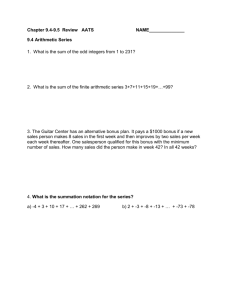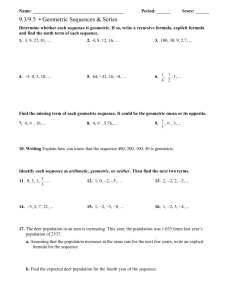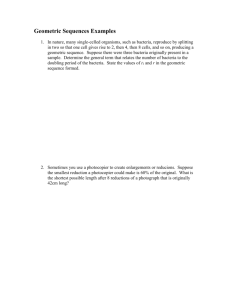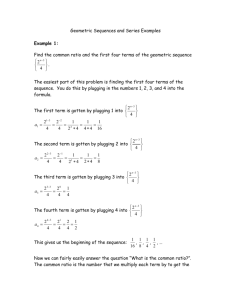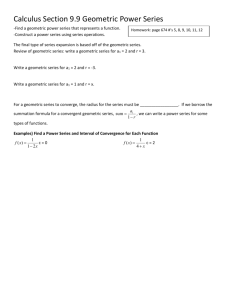Activity 5.6.1 Finite Geometric Series
advertisement
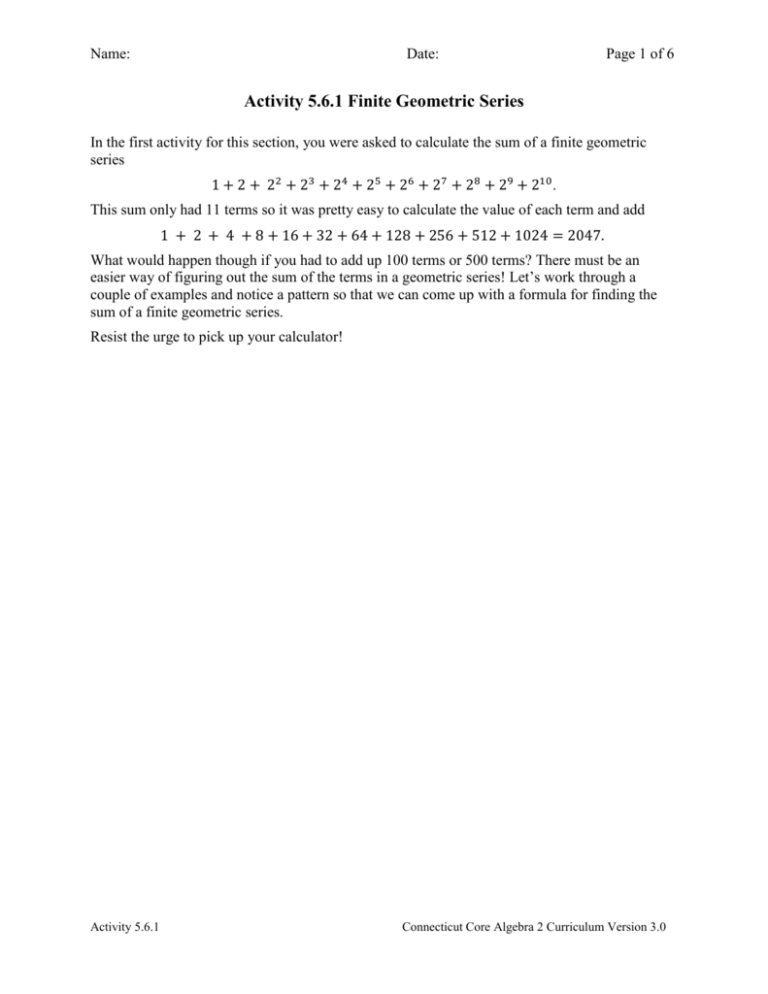
Name: Date: Page 1 of 6 Activity 5.6.1 Finite Geometric Series In the first activity for this section, you were asked to calculate the sum of a finite geometric series 1 + 2 + 22 + 23 + 24 + 25 + 26 + 27 + 28 + 29 + 210 . This sum only had 11 terms so it was pretty easy to calculate the value of each term and add 1 + 2 + 4 + 8 + 16 + 32 + 64 + 128 + 256 + 512 + 1024 = 2047. What would happen though if you had to add up 100 terms or 500 terms? There must be an easier way of figuring out the sum of the terms in a geometric series! Let’s work through a couple of examples and notice a pattern so that we can come up with a formula for finding the sum of a finite geometric series. Resist the urge to pick up your calculator! Activity 5.6.1 Connecticut Core Algebra 2 Curriculum Version 3.0 Name: Date: Page 2 of 6 Example 1 We will determine a formula to find the sum 1 + 9 + 92 + 93 + 94 + 95 + 96 . Set-Up: Start by identifying some important parts of the series. a. What is the common ratio 𝑟? b. What is the first term 𝑟1? c. How many terms are in this finite geometric sequence 𝑛? Step 1: For the development of the formula, we are going to introduce a variable S. S represents the value of the sum. Equation (1) S = 1 + 9 + 92 + 93 + 94 + 95 + 96 Step 2: Now that we have an equation, we are on our way! Multiply both sides of the equation (1) by 9. The right hand side of the equation should still be written as a sum of powers of 9. Equation (2) 9𝑆 = Step 3: Sometimes when you are creating a formula, the equation appears to get more complicated. That is what is going to happen initially in this step. Subtract the equation (1) from equation (2). Keep the expressions with S on the left and the geometric sums on the right. 𝐸𝑞𝑢𝑎𝑡𝑖𝑜𝑛 (3) 9𝑆 − 𝑆 = Step 4: The geometric sums have many terms in common whose differences are zero. Simplify equation (3). Equation (4) 8𝑆 = Step 5: Almost there! Keep in mind you are trying to find the sum 𝑆 of the finite geometric sequence. Solve equation (4) for 𝑆. Check: Evaluate the expression you received in the last step. Pull out your calculator and add up the terms. Do the answers match? Activity 5.6.1 Connecticut Core Algebra 2 Curriculum Version 3.0 Name: Date: Page 3 of 6 Reflect: During the set-up phase, you identified 𝑎1 , 𝑟, and 𝑛. Do these values show up in your formula from step 5? Explain which ones show up and where. In step 2 you were asked to multiply both sides of the equation by 9. Why do you think 9 was chosen? Activity 5.6.1 Connecticut Core Algebra 2 Curriculum Version 3.0 Name: Date: Page 4 of 6 Example 2 Now you will determine a formula to find the sum 3 + 3 ∙ 5 + 3 ∙ 52 + ⋯ + 3 ∙ 529 . Set-Up: Start by identifying some important parts of the series. a. What is the common ratio 𝑟? b. What is the first term 𝑎1 ? c. How many terms are in this finite geometric sequence 𝑛? Step 1: Let S represent the value of the sum. Equation (1) S = 3 + 3 ∙ 5 + 3 ∙ 52 + ⋯ + 3 ∙ 529 Step 2: You need one more equation. What are you going to multiply both sides by in this example? Multiply both sides by that number and get a new equation. Steps 3-5: Find the difference of the equations from steps 1 and 2 and solve for 𝑆. HINT: As part of the simplifying process, at some point factor out the GCF from the right hand side. Reflect: During the set-up phase, you identified 𝑎1 , 𝑟, and 𝑛. Do these values show up in your formula from the last step? Explain which ones show up and where. Compare the formula found for this example with the formula found for the previous example. State any similarities and any differences. Activity 5.6.1 Connecticut Core Algebra 2 Curriculum Version 3.0 Name: Date: Page 5 of 6 Finally a Formula! From the last two examples, you probably have a good idea of what the formula for finding the sum of a finite geometric series looks like. Let’s derive the formula with one last example. Now you will determine a general formula to find the sum 𝑆 = 𝑎1 + 𝑟𝑎1 + 𝑟 2 𝑎1 + ⋯ + 𝑟 𝑛−1 𝑎1 . Step 1: Let S represent the value of the sum. 𝑆 = 𝑎1 + 𝑟𝑎1 + 𝑟 2 𝑎1 + ⋯ + 𝑟 𝑛−1 𝑎1 Step 2: You need one more equation. What are you going to multiply both sides by in this example? Multiply both sides by that quantity and get a new equation. Steps 3-5: Find the difference of the equations from steps 1 and 2 and solve for 𝑆. HINT: This time you should factor GCF from both sides. Now that we have a formula, are there any restrictions? Hint: The formula is a quotient. Does that pose potential problems? Reflect: Compare the formula you obtained from this last example to the formula you made based on Examples 1 and 2. Was your predicted formula correct? Will the formula from this example also work with Examples 1 and 2? Activity 5.6.1 Connecticut Core Algebra 2 Curriculum Version 3.0 Name: Date: Page 6 of 6 Try Using the Formula Elyse loves to read books in the summer. During the first week of summer vacation, she read just ¼ of one book. Each week after the first, she reads three times the number of books that she read the week before. So week 2 she reads ¾ of a book.Her summer vacation is 6 weeks long. Write a finite geometric series that represents the number of books she read over summer vacation. a. What is the common ratio 𝑟? b. What is the first term 𝑎1 ? c. How many terms are in this finite geometric sequence 𝑛? How many books did she read during her 6 week summer vacation? The Opener for Today’s Lesson If this folding were to continue for 50 folds, what would be the total number of rectangles generated? Do you think the answer on your calculator is rounded or exact? Explain. Activity 5.6.1 Connecticut Core Algebra 2 Curriculum Version 3.0

